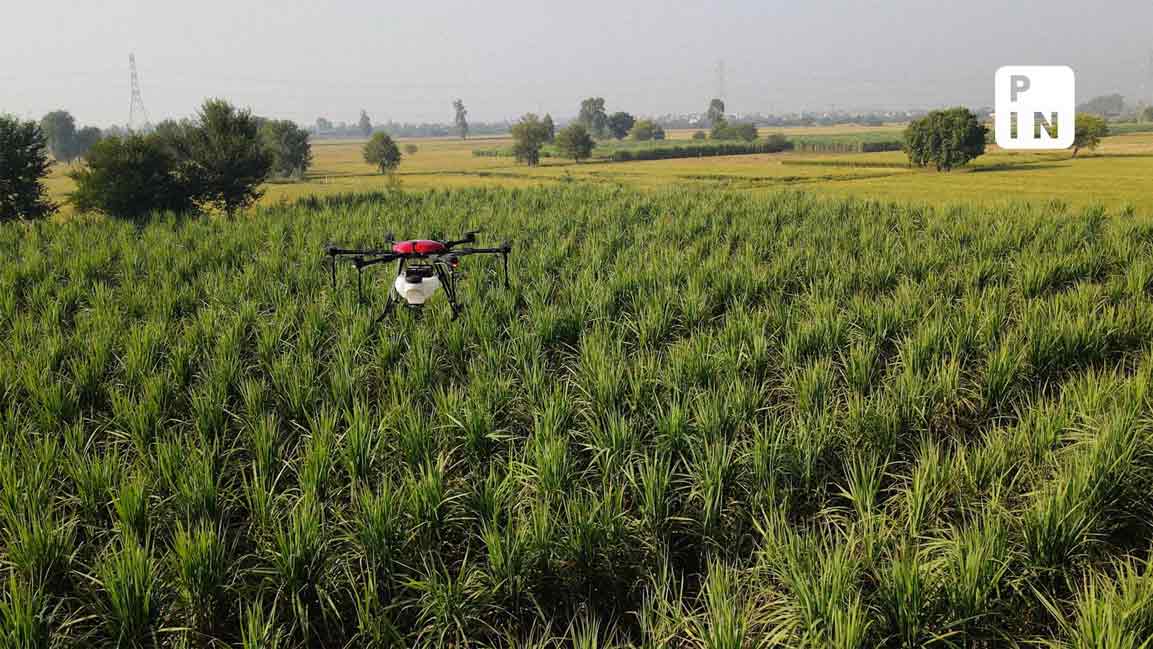- | 2:00 pm
How drones are reshaping India’s farm landscape
Agricultural drones are helping Indian farmers slash chemical use, boost crop productivity, and save time

Video editor: Rahul Sanpui
“It would take us five to seven hours to spray pesticides on one acre of crop with a hand-held machine. It takes us five to seven minutes with the drone,” says Ajay Kumar, a farmer in Haryana’s Bhiwani, a town on the outskirts of India’s capital, New Delhi.
Kumar says he also has the option of using tractors for spraying.
But that would still require laborers, who are not always easy to find in peak season.
Besides, using a tractor for spraying involves drawing pumps through the field, which would damage the crops.
“The plants would snap or fall if someone enters the field while the crop is getting ready for harvesting,” Kumar, who owns several acres of farming land in Bhiwani, says.
“Drones have solved this issue. We just supply them with pesticides and water, and the drone does the rest. The entire work is done in an hour,” Kumar adds.
Govt push for farmer drones
Drones are revolutionizing Indian agriculture in a manner akin to the transformative impact of tractors and threshers during the Green Revolution in the 1960s and 1970s.
These kisan (farmer) drones, used for precision spraying of pesticides and fertilizers, assessing crop health, and monitoring fields, are enhancing productivity, managing time efficiently, and reducing chemical use.
Despite agriculture employing 55% of India’s population, technological adoption in farming has been slow due to limited awareness and financial constraints. However, government initiatives are promoting technology use to boost productivity and farmer incomes.
The government sees drone technology as transformative for Indian agriculture.
“We can see today that our farmers are interested in using drone technology. This will take our agriculture sector to the next level,” Prime Minister Narendra Modi had said in May 2022.
Inaugurating a drone festival—Bharat Drone Mahotsav 2022—Modi said the technology will play a key role in empowering farmers and modernizing their lives.
Saving time and money
There are two types of drones being used for spraying in Bhiwani—one running on a lithium-ion battery and another powered with a petrol engine. The battery-operated drone can cover up to 2.5 acres on a single charge and usually takes nearly seven minutes to spray on a one-acre farm.
“We maintain the height according to the crop. The nozzle [on the spraying drone] covers the entire plant. It can cover 8-10 square feet of area at a go. The remote also shows the area that has been covered,” says Naresh Singh Dayal, a drone pilot working with a startup that provides agricultural drones to farmers in Bhiwani.
Satyapal Singh, a 62-year-old farmer who owns 35 acres of agricultural land in Bhiwani, says drones save him both time and money.
“We were using hand-held spray machines, we then started using tractor-operated spray machines, and now we use spray drones,” he says.
Drones are especially useful for spraying in sugarcane fields as it becomes extremely difficult for laborers with spray machines to enter the field. The size of the crop is no longer a concern with drones.
It is, however, becoming difficult for farm laborers who operate these machines to find employment.
“When the paddy sowing is done, the spraying season begins. I bought a machine for ₹10,000 ($120) for spraying and usually earn ₹30,000 ($360) in the seasons which is for about one or two months,” says Hardip Sharma, a migrant farm laborer.
“Drones are making it hard for us to find spraying work. How would I send money back home if I can’t find work? The whole family will suffer,” says Sharma.
Dayal says his company has a solution for those who may lose their employment because of the rising use of drones. There is, however, a minimum education requirement of matriculation, which many farm laborers like Sharma may not have.
“You only need to have a minimum education of class 10th to become a drone pilot. We will hire these laborers as co-pilots and later promote them to become pilots,” Dayal says.
Union minister Anurag Thakur claimed in 2022 that India would need over 100,000 drone operators by the end of 2023.
Lalita, a recent graduate with a Bachelor of Arts (BA) is one such person. Currently working as a drone co-pilot, Lalita hopes to soon become a pilot after training.
Thakur also claimed that agricultural drones would benefit over 100 million farmers by 2023.
Mansukh Mandaviya, the Union minister of chemicals and fertilizers recently shared his experience of spotting the use of drones to spray liquid fertilizers.
“Gone are the days of tedious and time-consuming manual spraying of pesticides and liquid fertilizers through hand pumps; it is gradually getting replaced by a much more efficient and productive technique of spraying by means of drones,” he said an in article in the Hindustan Times.
While large and medium farmers (with landholdings above 4 hectares) can employ drone services, small and marginal farmers may still prefer manual methods.
Drone spraying charges range from ₹700-1000 per acre, a significant amount for most of the Indian farmers. According to a 2015-16 survey on Indian farm holdings, the average holding size in the country is just 1.08 hectares (2.6 acres), and 86 percent of holdings are of less than 2 hectares (5 acres) in size.
With a battery-operated drone costing nearly ₹650,000 ($7,800) and a petrol-operated one costing around ₹1,250,000 ($15,000), it may even be beyond the reach of many medium and large farmers.
Kumar proposes a solution. He plans to buy a drone to use not just in his field but also rent it out to smaller farmers who may not be able to buy it.
“The drone is a new technology. We will use it to spray in our fields, and also in the fields of other farmers who want to buy it but can’t afford it. I want to buy it and put it to use in our village,” he says.
Govt spends $17 million on kisan drone scheme
The central government is actively promoting the use of drones through the sub-mission on agricultural mechanization (SMAM).
According to the data made available by the ministry of agriculture & farmers welfare in December 2023, ₹141.39 crore ($17 million) have been released towards kisan drone promotion which includes ₹52.50 crore ($6.32 million) released to the Indian Council of Agricultural Research (ICAR) for purchase of kisan drones and organizing their demonstrations on the farmers’ fields.
The scheme provides financial assistance of 40% up to a maximum of ₹400,000 ($4,815) for individual farmers. For the small and marginal, scheduled caste-scheduled tribe, women, and northeastern farmers, the financial assistance is 50% of the cost up to a maximum of ₹500,000 ($6,019), Union agriculture minister Arjun Munda said in a written reply in Lok Sabha on 12 December.
Financial assistance of 40% up to a maximum of ₹400,000 ($4,815) is given for the purchase of drones by custom hiring centers (CHCs) under the cooperative society of farmers, farmers producers organizations (FPOs) , and rural entrepreneurs to make available drone services to farmers on rental basis.
Agriculture graduates establishing CHCs are eligible to receive financial assistance of 50% of the cost of drones up to a maximum of ₹500,000 ($6019) per drone.
The funds have also been provided to the state governments for the supply of 461 kisan drones to farmers on subsidy and the establishment of 1,585 kisan drone CHCs to provide drone services to the farmers.
The government also recently approved a central sector scheme for providing drones to the women self-help groups with an outlay of ₹1261 crore ($152 million).
The scheme aims to provide drones to 15,000 selected self-help groups for providing rental services to farmers for agriculture purposes.













